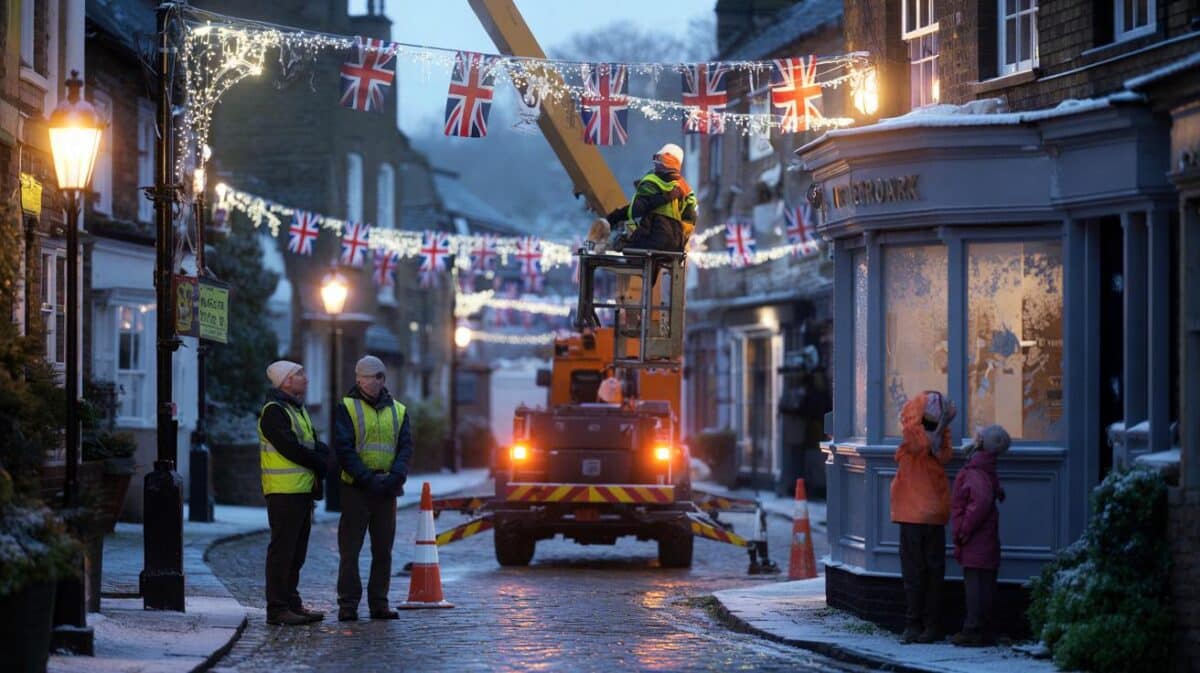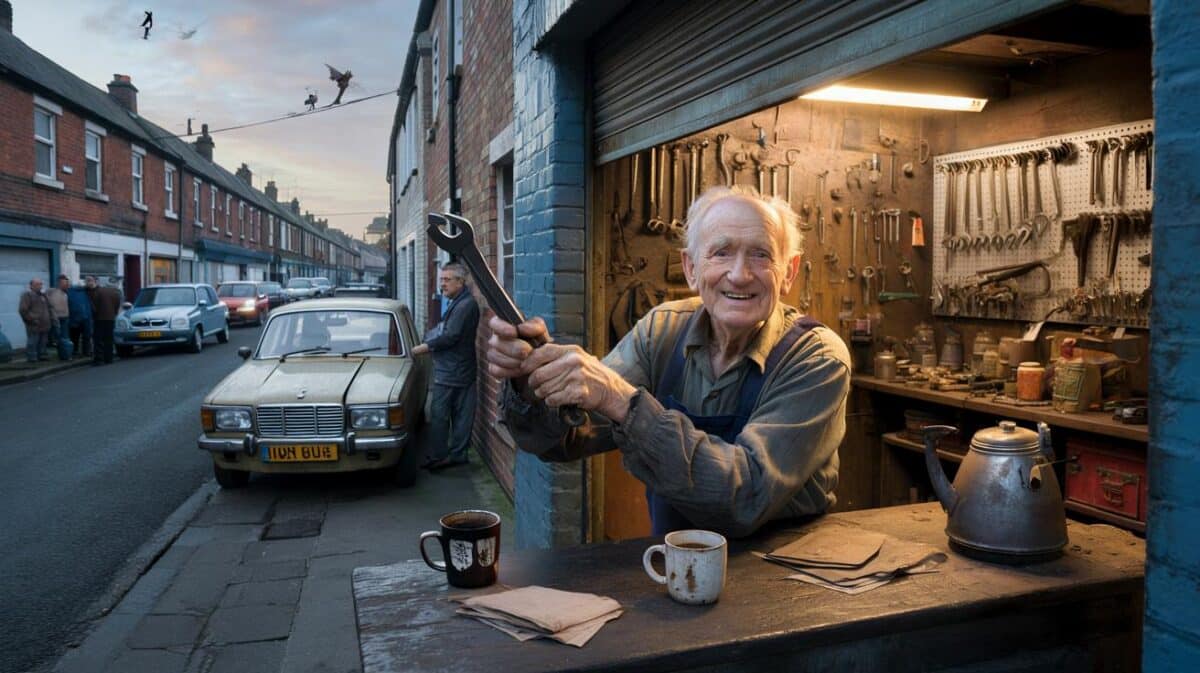In a small English market town, the annual ritual began like it always does: hauling out the same tinselled archways and faded plywood sleigh that have framed the High Street since the early 1970s. Only this time, while shifting a creaky panel behind the decorations, volunteers found something none of them expected: a sealed slice of their past, tucked away in plain sight for half a century.
Someone put the kettle on the windowsill, because the table was jammed with cracked baubles and a smiling plastic reindeer whose nose had yellowed with time. June, who always climbs the ladder because she “doesn’t look down,” loosened a stubborn bracket hidden behind a plywood Santa. The panel gave with a pop.
Out slid a narrow red postbox, the kind you’d bolt to a grotto wall. A hush fell, like the whole room put a finger to its lips. Inside, bound in twine and dust, were hundreds of children’s letters to Father Christmas dated 1974.
They were still sealed.
The find behind the faded tinsel
There was a moment of disbelief, then laughter that sounded like relief. The envelopes were tiny, scuffed, and addressed in careful pencil: “Dear Father Christmas, Market Hall, Grotto.” Names leapt from the past — Karen, Mo, Sammy with a star doodle — each stamped with an old green Machin head. People took turns holding the bundle, palms flat, as if balancing a bird.
Downstairs in the council chamber, they laid the letters in neat lines on trestle tables covered with brown paper. Each envelope felt warm with stories. A few older faces in the crowd recognised their own schools from return addresses — the old infants on Church Lane, the pre-fab classrooms by the allotments. It was the sort of discovery that makes a town go quiet, just for a beat, and listen properly.
One envelope was thick, the handwriting almost upright with effort. When carefully opened, the letter inside started with “I hope you are not too tired” and went on to ask for a farm set and “something nice for Mum because she does the hoovering when the lights are on.” In 1974, Britain lived through the three-day week and rolling power cuts, so the line lands with a thud of reality. Little hands had written what the grown-ups wouldn’t say out loud. That’s what these finds do — they smuggle the era’s weather into the room.
It’s tempting to file this under charming nostalgia, to smile and move on. That misses the deeper point. The fact these letters survived, tucked behind a 50-year-old Santa and an annual routine, says something about how towns carry themselves through time. Decorations, after all, get repeated until they become invisible. The grotto’s backboard was never taken down fully, the postbox never reclaimed, the twine never cut. So a small, ordinary oversight became a time capsule. The lesson? **History often hides in the glue of the everyday.**
What to do when your past turns up in a box
First, pause. Don’t rush to peel, flatten, or post on social media. Paper from the ‘70s can be brittle, and envelope glue dries into a crust that tears when tugged. Wear clean cotton gloves if you have them, and work on a stable surface away from radiators or direct sun. Snap photos in soft light. Label as you go — a simple pencil note like “Bundle 1: loft find, 12 Nov” will save you later.
If letters must be opened, try steaming nothing and forcing nothing. Speak to a local archivist about using micro-spatulas to lift flaps and softening the adhesive with controlled humidity. Let’s be honest: nobody actually does that every day. If you can’t find an expert, open the empty ones first to practise, and log each move. A notebook with dates, initials, and a quick line on condition will be gold if the town decides to exhibit or digitise what you’ve found.
Language matters too. These are intimate notes meant for one reader in red. Treat them like diaries. One archivist I spoke to summed it up with rare clarity:
“Think of each letter as on loan from a person you might bump into on the High Street. Act accordingly — gently, and with a bit of grace.”
- Store flat in acid-free folders or between clean, unprinted card.
- Photograph both sides before and after opening.
- Record names, dates, schools, and any details that could help find writers or families.
- Avoid tape, glue, or laminating. Those are forever in the worst way.
- Reach out to your county archive or local museum for guidance and a humidity-safe box.
Why it matters more than a warm glow
We’ve all had that moment when you open a box and a smell or a scrawl yanks you back so hard you have to sit. These letters are that moment scaled to a town. They’re a map of what people wanted, worried about, hoped for — pram-sized wishes set against the clatter of strikes, candlelit dinners, and everyone’s breath fogging in the lounge. **The human details** do the heavy lifting.
Curiously, the find also shows how traditions protect memory by accident. The same arch, the same lights, the same volunteers keeping the thing going because it’s what you do. In that repetition, anomalies stick. The postbox hid because it looked like part of the set. The yearly hurry to get Santa up and the grotto open meant no one questioned the backboard. Routine became a cloak; under it, history slept.
And then there’s the wild, tender possibility of reunion. Some of the writers will be in their late 50s or early 60s now. Some will still live streets away. Imagine a small exhibition in the library, letters displayed in their original envelopes, with space for visitors to add memories. Maybe a few will recognise their own clumsy loops. Maybe someone will find a parent’s note tucked inside. **A tinsel-thin time capsule** could spin out into conversations that last all winter. *It’s hard not to want that.*
From letters to living memory
Let’s talk next steps without the fuss. Create a simple, respectful plan: a small team, two tables, good light, and a sign-in sheet. Photograph everything. Start a digital folder with clear names and dates. Invite the local paper and the library to partner on a call-out: “Were you here in 1974? Did you write to Father Christmas at the Market Hall?” Keep the pace human. Once you have a handful of identified writers, record short audio clips of them reading their letter. That’s the spark.
| Key points | Detail | Interest for the reader |
|---|---|---|
| Hidden postbox discovered | Behind 50-year-old town decorations sat a grotto letterbox packed with 1974 letters to Father Christmas | Surprise, nostalgia, and a window into real childhood voices |
| Handle with care | Use gloves, avoid tape, digitise, consult local archives before opening | Practical steps you can use if you find family or community papers |
| Community ripple effect | Potential reunions, exhibitions, and oral histories across the town | Chance to participate, share memories, and reconnect with neighbours |
FAQ :
- What exactly was found?A vintage grotto postbox hidden behind the town’s long-standing Christmas set, filled with children’s letters dated 1974.
- Where were the letters discovered?In the loft space of the town hall, tucked behind plywood decorations that haven’t been fully moved in decades.
- Can the writers be contacted?Possibly. Many letters include first names and schools; a public call-out via the library, local paper, and social groups could help.
- Is it legal to open and display the letters?Yes, with care and context. Work with the local archive or museum to balance privacy, consent, and public interest.
- How can I help if I think one is mine?Bring ID and any proof like school photos or addresses from the time. Volunteers can match details and arrange a respectful reunion.









